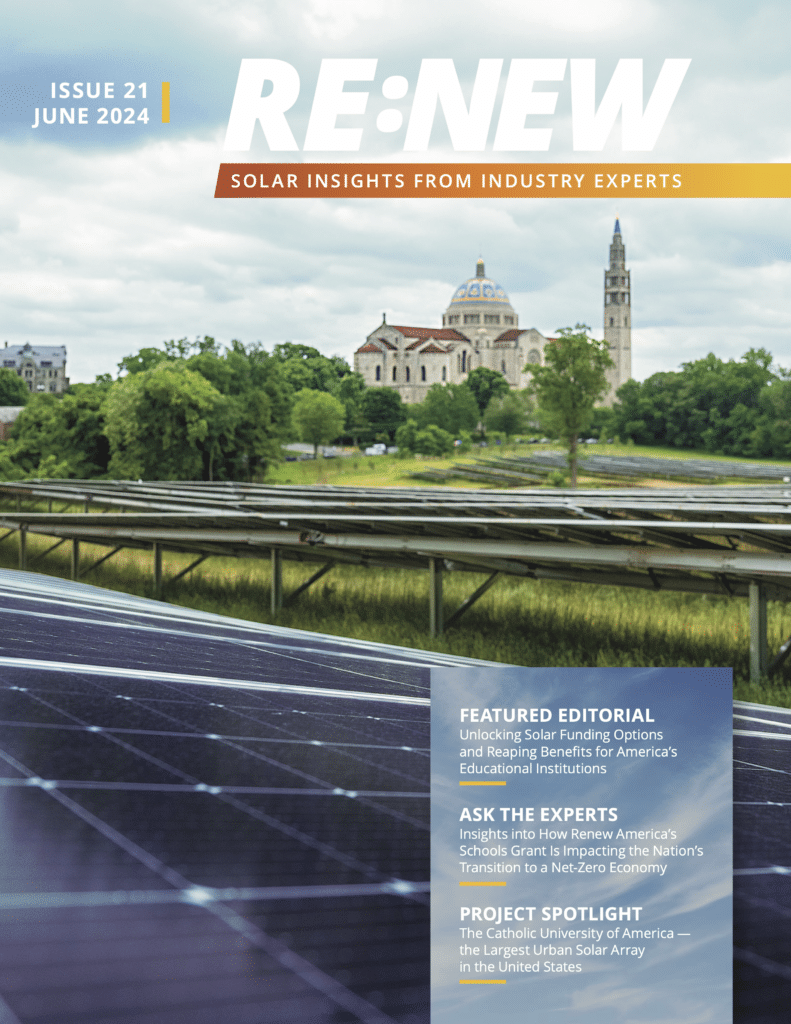As 2021 kicks off, the solar industry finds itself at an inflection point. With the election of President Joseph Biden and Democratic control of Congress, many are expecting a raft of legislative and regulatory decisions that are favorable to building the solar industry.
Here is a rundown of the federal and state policies we believe will help shape 2021:
Federal: First, the COVID-19 relief package that was passed by Congress at the end of 2020 provided an extension of the investment tax credit (ITC), one of the most effective drivers of the solar industry since it was first introduced in 2006.
Though it does not restore the ITC to its full 30% levels as some had hoped, it will remain at 26% for the next two years, be reduced to 22% in 2023 and will drop to 10% beginning in 2024 for commercial projects (the residential credit will disappear at the same time). The legislation also provides more funds for research-and-development (R&D) on reducing soft costs and offers rational access to federal lands for renewable energy projects.
The House Ways and Committee has introduced the GREEN Act, which would extend the solar investment tax credit (ITC) at 30% through the end of 2025, then phase down to 26% in 2026, 22% in 2027 and 10% thereafter. It will also establish a new stand-alone ITC for energy storage technology. It would be 30% through the end of 2026 then phase down to 26% in 2027 and 22% in 2028.
But the COVID-19 relief bill may just be the beginning. One of the first bills the new Congress will consider is the Energy Act of 2021, which would authorize $1 billion over five years for storage R&D, as well as pilot programs overseen by the U.S. Department of Energy (DOE) to improve and expand access to storage solutions for the solar industry as well as other renewable energy options.
In addition, the DOE is expected to provide up to $45 million to find solutions to grid integration as more solar projects come on to the grid. The emphasis is to be on using American-made hardware in solar installations moving forward.
Finally, the National Renewable Energy Laboratory (NREL), will be examining storage futures over the next several years. In a four-part series, NREL will take a look at how ever-improving storage technology could affect its deployment at both the utility-scale and distributed storage levels. It will also address how these systems could influence the future of power system infrastructure investment and operations.
Arizona: Legislation has been introduced into the Arizona legislature to curb the ability of the Arizona Corporation Commission (ACC)—the regulatory body that oversees utilities in the state—to adopt or enforce any policies that directly or indirectly regulate the type of critical electric generation resources on the Arizona energy grid unless the legislature specifically tells it to do so. Solar falls into the “critical electric generation resources” category, so the legislation, if passed, could limit the ACC’s ability to pass regulations to encourage solar development in the state.
To be fair, relations between the solar industry and the ACC have been fraught in the past, since Arizona Public Service (APS), the state’s largest utility, has overwhelming influence on the ACC thanks to its ability to make political contributions to the commissioners. This legislation bears watching because the future of the solar industry in the state could hinge on the outcome.
Arkansas: Regulators are requiring utilities to offer alternatives to net metering starting in 2023.
California: In California, a bill has been introduced that would require the California Secretary for Environmental Protection to convene a newly formed Photovoltaic Recycling Advisory Group to discuss what steps the state legislature could take to ensure solar modules are and other equipment are recycled instead of consigned to the state’s landfills. The bill sets a deadline of April 1, 2022 for the group to hold its first meeting, and it mandates that the group report its findings to the legislature on or before April 1, 2025.
Solar end-of-life disposal is an area that is growing in importance as the industry continues to mature. As we all know, what happens in Californian solar policy often migrates to the rest of the country, so the work this group will do could influence the way we dispose of solar projects across the country in the not-too-distant future.
Finally, the California Energy Commission is set to help Native American tribes improve clean energy access on Tribal lands with a $2 million grant program. It will provide funding for clean-energy feasibility studies for eight California tribes.
Delaware: The Delaware legislative session is off to a good start, passing legislation to increase the state’s renewable portfolio standard (RPS) to 40% by 2035, up from 25% in 2025 (legislators say the state is well on its way to hitting the lower goal). In addition, the solar carve-out in the RPS would go to 10% by 2035, up from 3.5% currently.
Hawaii: The ease of solar permitting—or lack of it—is an ongoing challenge facing the industry. Complicated permitting requirements across different jurisdictions can leave solar companies confused and angry as they make their way through the process. In one Hawaiian city, elected officials are trying to change that.
The mayor of Honolulu signed Bill 58 into law in December, which will direct the city planning commission to develop expedited permitting procedures for solar and storage projects 20 kilowatts or smaller. The goal is to move all permitting online and aim to approve all such solar projects within 14 days after submission. Though it is currently only one city, it could become a pathway for other cities in the state to follow.
Illinois: The state of the solar industry in Illinois is currently up in the air. After the Illinois Power Agency decided to end all state renewable energy incentives, some observers have suggested that essentially shuts the solar industry (and other renewable industries) down completely.
Since the state has a policy requirement to achieve a goal of receiving 25% of all its electricity from renewable sources by 2025, the development is distressing to say the least. The hope is that new legislation (yet to be introduced) will renew funding to the incentive programs, but whether that actually happens remains to be seen.
Separately, a bill has passed both houses of the legislature that instructs the Illinois Commerce Commission to develop a study that would look at the costs and benefits of energy storage systems.
Iowa: Legislators in the Hawkeye State are pushing forward with their shift to value-of-solar pricing for solar energy, though no rate changes will occur before 2027.
Kansas: One utility has proposed a minimum bill alternative to a distributed generation capacity-based charge.
Massachusetts: The Commonwealth has started the year off strong by passing “An Act Creating A Roadmap for the Next Generation of Climate Policy,” which not only has provisions to improve the deployment of clean energy in the state, but also includes a compromise plan to clarify how solar energy is treated in its tax code. Under the compromise, residential and small businesses will not see an increase in property taxes if they install small solar systems. Larger systems will also be exempt from paying taxes if they have alternatives already in place under their agreements.
The compromise is expected to spur new investment in the solar industry in the Commonwealth and help spread the Solar Revolution to more places in the state. And in response to a veto by Gov. Charlie Baker at the end of last term, Democratic state representatives have said they will reintroduce a bill to move the state’s renewable portfolio standard (RPS) to 40% by 2030 and increase access to solar energy for low-income populations.
Minnesota: In a state where the legislature is split (the Senate is Republican and the House is Democratic), leadership on climate change and clean energy are currently being driven by Gov. Tim Walz. He most recently put together a package of proposals that would accelerate the state’s 100% clean energy mandate by 10 years, setting a new goal of reaching 100% clean energy by 2040 instead of the current goal of 2050.
New Jersey: Legislators are considering making its community solar pilot program a permanent part of the state’s solar mix. In 2020, the Senate passed a bill that would mandate it, but it didn’t pass the House. The Senate has indicated it will take up the provisions again in the new session. The legislature is also set to streamline the income-verification process for low-income community solar subscribers.
New Mexico: Legislation has been introduced that would build on 2019’s Energy Transition Act by requiring utilities to reduce carbon pollution by 4% each year until the Energy Transition Act’s complete decarbonization goals are met.
New York: Governor Andrew Cuomo outlined aggressive plans to build 23 new solar farms in the state this year. Upon completion, that would mean the state has more than 100 clean energy projects built under his administration. The plan for 2021 will also include one hydroelectric facility. Together, the projects should produce 2.2 gigawatts of energy, bring in more than $2.9 billion in private investment and create nearly 4,000 jobs.
In addition, the state will further expand its energy-storage goals and has already begun construction on a 20 megawatt battery project in upstate New York, which brings the total amount of energy storage projects to nearly 1 gigawatt. The New York State Energy Research and Development Authority (NYSERDA) says that with the new storage capacity being added, more than 1.2 million New York homes will be able to use renewable energy.
Finally, the New York Power Authority (NYPA) is continuing to develop a strong community solar program for the state. In the next four years, it suggests it will be supporting at least 40 community solar projects totaling 75 megawatts and include 15 megawatts of paired storage. In total, the NYPA projects are expected to bring in more than $135 million in direct, private investments and create more than 1,250 short-term and long-term jobs.
Oregon: The Oregon Public Utility Commission has delayed low-income-subscriber requirements for its community solar program.
Pennsylvania: Legislative language is anticipated this month for fast tracking community solar and will likely include a two-phased approach, first to prop the market up immediately and then to transition into a value stack model to be determined by a lengthy stakeholder process managed by the Public Utilities Commission.
Rhode Island: The state, which through executive order decided in 2020 to meet 100% of the state’s electrical needs from renewable energy in the next 10 years, has issued a report early in 2021: The Road to 100% Renewable Electricity – The Pathways to 100%. In it, the Rhode Island Office of Energy Resources (OER) examined the key factors that will affect the way the state reaches that goal: decarbonization, economics and policy implementation.
In its conclusions, the report believes the state will need 4,600 gigawatt-hours of additional renewable energy to meet its electricity needs by 2030, which would represent an increase in available renewable energy of nearly 150%.
South Carolina: Regulators are considering implementing a monthly minimum bill to accommodate solar customers.
Utah: In the Beehive State, the public service commission decided to split the difference and set net-metering rates between retail cost and the avoided costs of exported energy.
Virginia: Building on 2020’s rousing success with the passage of the Virginia Clean Economy Act (VCEA), this year’s Virginia legislature is poised to take up even more clean-energy-related legislation. Regional associations are in discussions to put forth legislation to extend the Department of Environmental Quality’ “Permit by Rule” program to hybrid (solar + storage) and standalone storage projects, as well as a budget amendment to install two mobile solar labs and fund their operations, which will allow for statewide expansion of the state’s solar workforce training program.
In addition to focusing on solar expansion, House Bill 2148 is already up for discussion. The bill would extend the regulatory review avoidance currently available to solar projects to solar + storage and standalone storage projects as well. House Bill 2006 would also expand protections for rural areas of the state to guarantee they receive revenue from energy storage projects similarly to the provisions that make such a guarantee for solar projects—by decreasing tax exemptions over time or through revenue sharing.
Finally, Virginia regulators have authorized a minimum bill proposal for shared solar customers.
Washington: The legislature will consider House Bill (HB) 1046, which would establish a community solar program in the state. While details of the bill are unclear, it would urge the regulatory and legislative bodies of the state to create a vibrant community solar program, which is a fast-growing segment of the industry that could grow the solar industry in the state significantly.
Though legislative agendas are still being formed across the United States, early indications are that renewable energy in general—and solar in particular—are going to be at the forefront of the debates we will be having in 2021. Remember that your advocacy can affect the way solar policy is made in your state, so be sure to get involved. Together, we can make 2021 the best in the history of the industry—but only if we make it a priority.
More Recent Blog Posts
The Politics of the Inflation Reduction Act: Standard Solar’s September Policy Brief
September 13, 2024
Trevor Laughlin · 4 min read
Community Solar, Front And Center: Standard Solar's August Policy Brief
August 12, 2024
Trevor Laughlin · 3 min read
A Mixed Legislative and Regulatory Landscape: Standard Solar’s July Policy Brief
July 15, 2024
Trevor Laughlin · 4 min read
Community Solar, Front And Center: Standard Solar's June Policy Brief
June 18, 2024
Trevor Laughlin · 3 min read
Most Popular Blog Posts
How To Create A Complete Commercial PV Design Package
CJ Colavito · 8 min read
New California Legislation Takes Community Solar Access to New Heights
Harry Benson · 8 min read
State Policy Leaps Into The Spotlight As Federal Policy Winds Down
Travis Tate · 8 min read
The Challenges of Finance and Interconnection Across Multiple States
Scott Wiater · 8 min read







Share